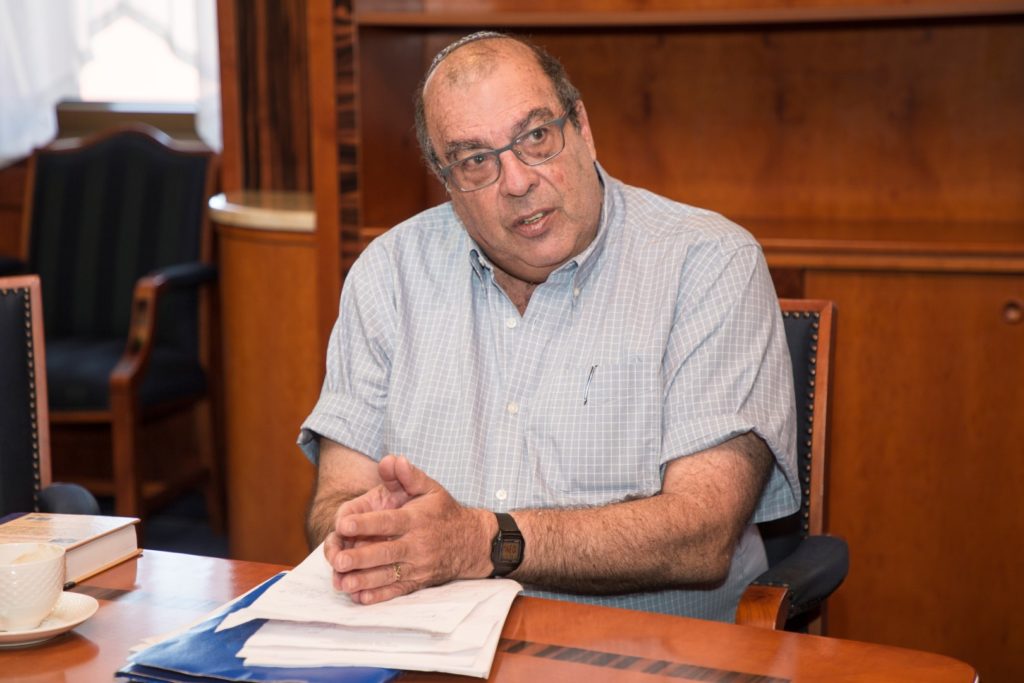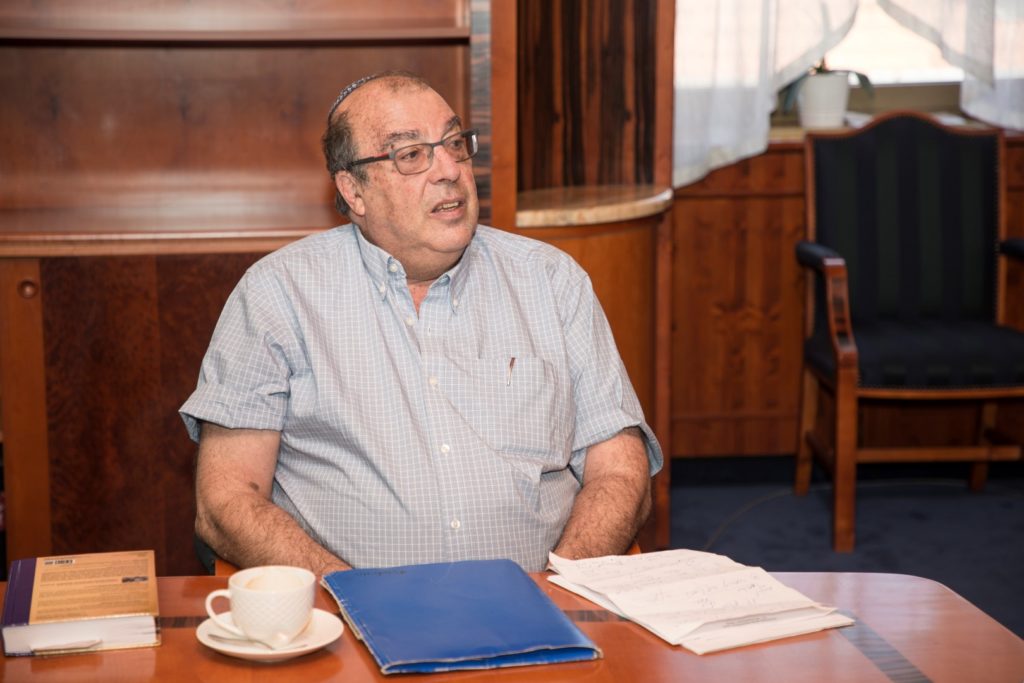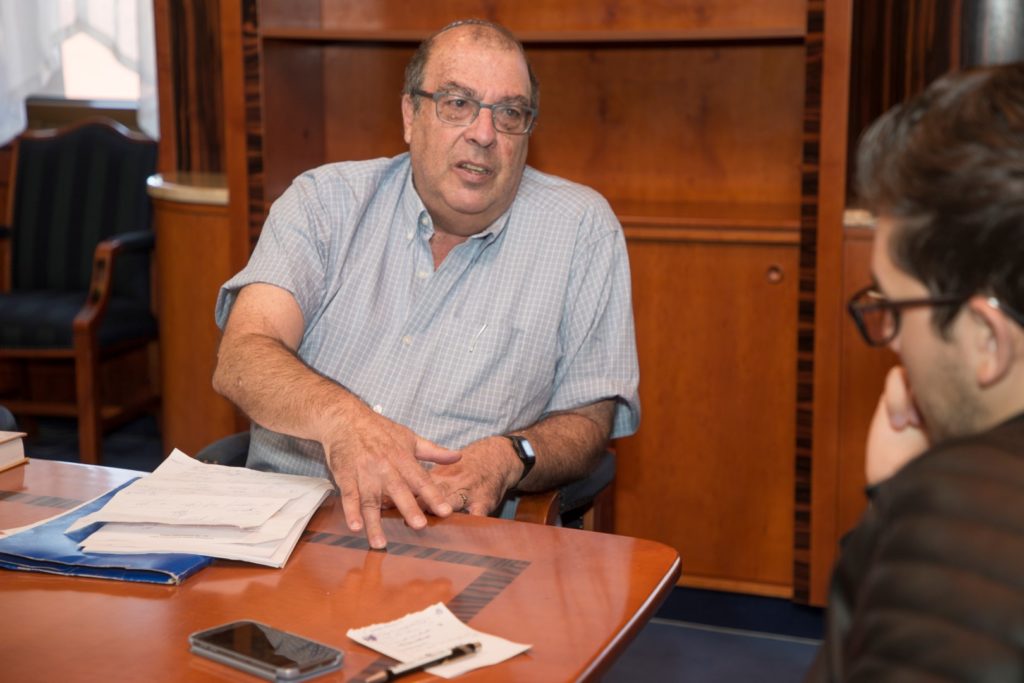Few subjects are as hotly debated today in Hungarian Jewish circles as the House of Fates. Yitzchak Mais, former director of Yad Vashem’s historical museum and leader of the project spoke to Neokohn about the leaked vision document, accusations against the project by some local Hungarian historians and why the House of Fates will be unlike any other museum.
***
A certain vision document connected to the House of Fates has been leaked to the Hungarian press a few weeks ago and while some acknowledged it as a professional piece of work, some historians called it poor, and others accused the project of having tried to force them into cooperation. How did the document get leaked? Are you planning to sue anybody?
I deal with content, and not with politics. That paper was a preliminary document of a general vision defining general themes, guidelines and values for the narrative. As part of the creative process we show at every major stage of the project the content to local historians, educators, sociologist etc. We do so because it is important to get professional feedback. Once we get the feedback, comments and remarks we finalize the projects current stage.
The leaked document was a working copy in process – and not a final version.
I am glad many professionals were and are open to give us professional feedback. We are never looking to say “sign on this”, rather we say “here are our ideas, we think that you are serious historians, we’d like to get your opinion”. This was the case for historians introduced to me from Milton Friedman University’s Institute of Hungarian Jewish History as well. Unfortunately, I’ve come to learn that in Hungary it is easier to criticize than to give feedback. I’ve worked on museums in New York, Chicago and Montreal, yet I’ve never experienced anything like this. I don’t understand why didn’t they just come back and say “you got this or that wrong”, as many others that did so. Instead of that came the articles in the press. I understand that it is connected to politics, but I have no political agenda. I don’t want to be popular, I want to be authentic.

I have noticed several embarrassing mistakes in the document myself. Don’t you think you should have gotten at least the name of the Arrow Cross movement right?
As I said this was a working copy. Many people work in such a process and we are all not perfect, we make mistakes. Specifically, in this case the English proofreader “corrected” the original text and changed it to “iron cross”. Many of us recognized that mistake and have corrected it back long ago. The way you avoid making mistakes in the final version is precisely by showing your work to other professionals beforehand. I knew the general story of the Hungarian Holocaust when I came here, but now I have to consult with experts to know every detail. We are currently working together with some well-known local historians, who, I can assure you, are top-level scholars of the subject. What I can say for sure is that the Hungarian Holocaust was different than what happened anywhere else and so
the museum that we are going to make will be different than any other museum.
What makes the Hungarian Holocaust special in your view?
The Hungarian story is very unique in many aspects. In its context as well as the way things played out during the war, and in its’ aftermath. Our museum will be unique – since it is very rare that a museum focuses on the local story and doesn’t only speak about the general story of the Holocaust by the occupying Nazi Germans. Yes, we too will mention Nurenberg and what the Nazis did, but we will be dealing primarily with what took place in Hungary locally, and what happened to Hungarian Jews once they arrived in Auschwitz. Visitors to the museum all know the “end of the story”, how the Nazis came in and eventually the Jews were deported to Auschwitz. But before that there were no yellow stars, no ghettos, yet there were anti-Jewish laws, labor service, the deportations to Kamianets-Podilskyi and the massacre in Novi Sad.
Despite all this, Hungary was the safest Axis-allied country for Jews in Europe.
From Slovakia and Poland many Jews fled to Hungary and here they received help and false papers and food from local Jews. These were all Jewish responses to the Holocaust already before the German Nazis came here.
Some have argued that placing too large emphasis on Jewish resistance will give an uneven picture.
We will try to tell the Jewish perspective of the events: how the Jews understood what was going on and how they responded based on their understanding. The fact that they responded in various ways shows that they were not passive. Too often are Jews called “sheep who went to the slaughter”. I don’t agree with that, you cannot judge the victims. This of course was not the majority, but such responses were present. We will also try to touch on the contemporary mentality, the idea that “it cannot happen here”. This idea was present in other places throughout Europe, it was but much stronger here.

Others have claimed that the House of Fates will become a museum telling the story of orthodox Jewry only. Is that the plan?
We are going to build an inclusive museum. Between the treaty of Trianon and the Vienna treaties the majority of Hungarian Jews were not orthodox, especially in Budapest. I’d call them acculturated, not assimilated Jews. I mean that they spoke Hungarian, their culture was Hungarian, but many of them still wanted to be Jews. The family of Hanna Szenes was pretty liberal, but they still went to synagogue on Yom Kippur. But many orthodox Jews thought of themselves as patriotic Hungarians too. I met in Israel a hassidic man who was from Debrecen. He wore payot and had a long coat. He told me that at home they spoke Hungarian during the week and Yiddish only on sabbath.
You won’t find anything like that in Poland!
So what is then the attempt to show the “praying children in Auschwitz” you write about in the leaked vision?
After the Vienna Awards many Jews living in the Carpathian area became Hungarian citizens again. Their stories have often been ignored in the narrative. I am not a hassid, I am traditional. I am not out to make people saints. But my colleague Esther Farbstein discovered something that no one knew about. In the children’s barracks of Auschwitz there were many children from the Carpathian area along with a few Polish and Lithuanian Jewish kids. There they created a lifestyle that ensured that everybody received extra food, that there was no bullying, and they kept up their spirits by singing songs Friday night. Now I don’t believe in stories. For me oral history has to have at least two stories that independently confirm each other.
I have heard the following story about Rabbi Tsvi Hirsch Meisels of Vác from three people, one from Mexico, one from Cleveland and one from Israel. They spoke of it independently. When the kids in these barracks learned during Rosh Hashana that they would be executed the next day they asked Rabbi Meisels to come and blow the shofar for them. The overwhelming story is not this of course but that of Magyarization. Yet
the stories of how tradition was maintained during the Holocaust has to be told.
Some critiques of the project seem to have drawn their conclusions already. They are saying that the museum will whitewash the role of the Hungarian state.
I don’t think anybody honestly believes this accusation. No serious historian will ever put his name to such an attempt. The theory that “it all started in March 1944” is absurd. We make it clear even in the leaked preliminary vision document, that without the rise of antisemitic politics and policy in Hungary prior to the Holocaust, it would not have been possible to gain public support for the German Nazis and the collaborating Szotjay government to execute the deportations of over 430 thousand Hungarian Jews. We are also going to emphasize labor battalions to show how the ground was prepared for discrimination and how violent expressions of anti-Semitism happened.

Yet the main idea is that we have to tell the story to our basic audience in a way that they can internalize our historic and moral messages. If they go to the museum and are told that “you are terrible, you are evil, you are rotten”, then that will not happen.
We need to find the balance.
The Holocaust is like a black box. If you stare into it, you see nothing. But if you have a small ray of light for the few people, the exceptions like the around 800 Hungarian Righteous among the Nations who have been recognized by Yad Vashem, that small ray allows you to see things. But too many lights will blind you. That is whitewashing. We must do it in proportion so that students can ask themselves “which kind of Hungarian citizen do I want to be?” A good museum doesn’t “teach” per se but instead makes you think about what you saw 1-2 weeks later.
Yet another criticism raised against the vision document was that it sounded like a “trip to an adventure park”. Is it truly necessary to employ all this cutting-edge technology to convey your message?
We are not recreating Auschwitz.
You can’t say “I know what Auschwitz, or a labor battalion felt like”. You cannot know the hunger and the diseases. You cannot know what it was like to be on a train for four days without water, never. The latest educational studies also show that trying to shock the – especially young – visitors by the graphic brutality of the story is rather counterproductive then effective. So, our aim would never be to try to literally recreate the original environment. But we still need to find the means which can have the role of the intermediate to create an emotional and cognitive personal relationship to the story. We want to give visitors access to the experience and have more empathy and sensitivity.
This museum is meant for the general public. I am a public historian. I deal with taking complicated historical dynamics and simplifying them for the public without distorting historical authenticity. Novels and movies like the Son of Saul are also products of public history. A museum needs a narrative like in a book, it cannot be an encyclopedia.
Can you tell us a bit of where the Museum’s conceptual development is holding today? What are the things you are working on currently and also will there be a stage when the larger public will be allowed to become familiar with the plans?
We are currently parallelly working on further developing the concept into an actual room allocation plan and script, as well as developing the films and media for the exhibit. We are working with a very sophisticated museum design firm on the design as well as doing films and special effects with high-tech methods. There is a big emphasis now on collecting meaningful artifacts as well as personal testimonies. We are currently interviewing Hungarian survivors in Hungary, France, Israel and the US to give first person stories. Personal accounts will guide the visitor throughout the whole journey.
As I said before I strongly believe a museum needs to be inclusive and – thank God – rabbi Köves is on the same page with me on this. So
as part of this attempt, I think around the end of the year, we will start making public presentations of the plans in order to involve as many people as possible.
Veszprémy László Bernát összes cikkét elolvashatja itt.





